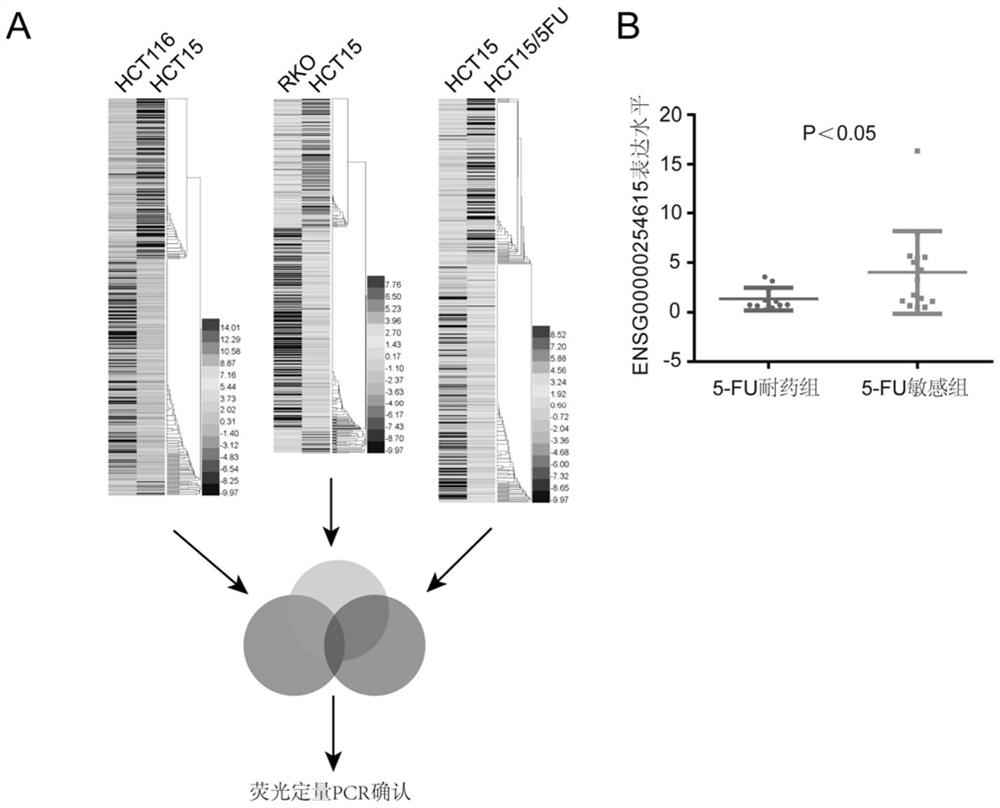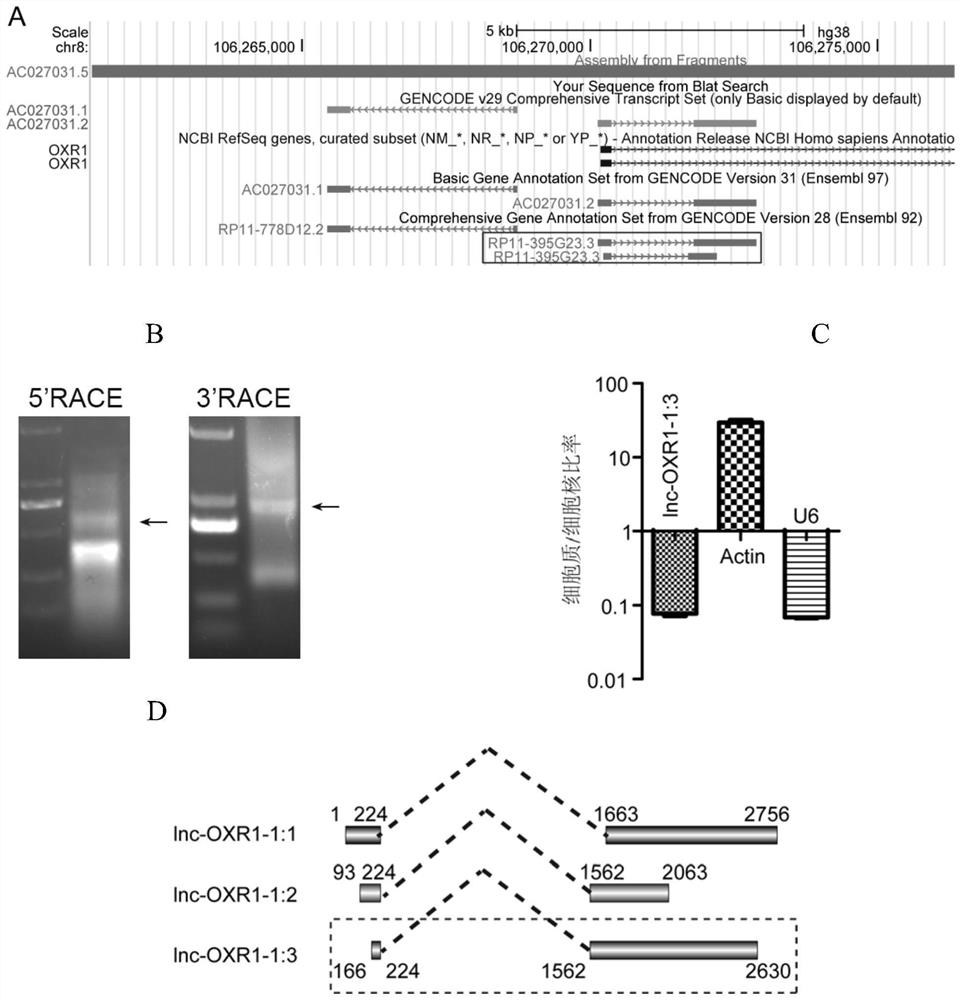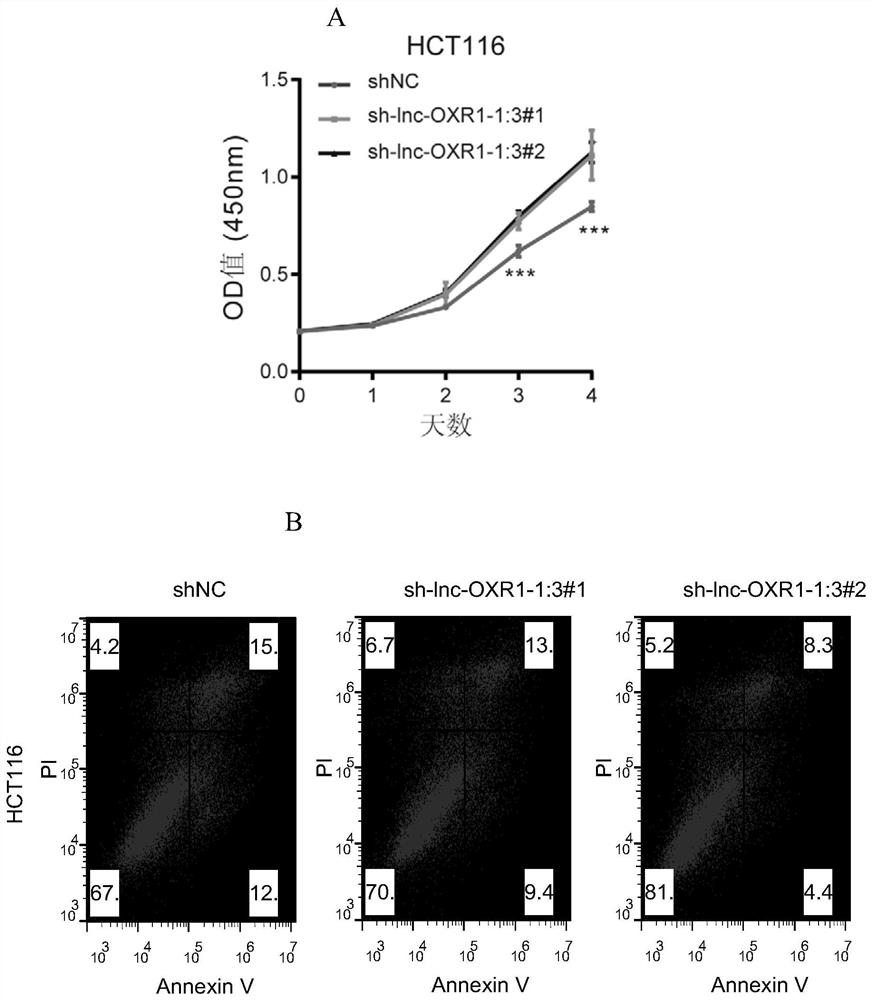Application of long non-coding RNA in regulation and control of colorectal cancer 5-FU drug resistance
A colorectal cancer, colorectal technology, applied in the field of bioengineering, can solve problems such as no suitable
- Summary
- Abstract
- Description
- Claims
- Application Information
AI Technical Summary
Problems solved by technology
Method used
Image
Examples
Embodiment 1
[0037] Example 1 found the differential expression of lnc-OXR1-1:3 in drug-resistant cell lines and sensitive cell lines
[0038] The inventors performed differential analysis on the RNAseq of four colorectal cancer cell lines (derived from ATCC) in vitro, including 5-FU relatively drug-resistant cell lines (HCT15, HCT15 / 5FU) and relatively sensitive cell lines (HCT116, RKO), Through the differential gene analysis of the three groups of HCT116 and HCT15, RKO and HCT15, HCT15 and HCT15 / 5-FU, and then take the intersection of the three groups of differential genes, the results are as follows figure 1 As shown in A. ENSG00000254615 with the most obvious difference was selected and verified by qRT-PCR, and the expression level was verified in drug-resistant colorectal cancer tissues and sensitive tissues. It was also found that ENSG00000254615 was highly expressed in sensitive tissues. The results are as follows figure 1 Shown in B.
[0039] In addition, the inventor found tha...
Embodiment 2
[0041] Reality Example 2 Relationship between lnc-OXR1-1:3 and colorectal cancer cells and drug resistance
[0042] In order to verify the relationship between lnc-OXR1-1:3 and colorectal cancer cells, the inventors used shRNA-mediated gene silencing expression method to down-regulate the expression of lnc-OXR1-1:3, the shRNA sequence used for expression is as follows :
[0043] shRNA#1
[0044] Justice Chain:
[0045] CCGGAAGCAAAAACACCTTTTTGAACTCGAGTTCAAAAAAGGTGTTTTTGCTTTTTTTG (SEQ ID NO: 2)
[0046] Antisense strand:
[0047] AATTCAAAAAAAGCAAAAAACACCTTTTTGAACTCGAGTTCAAAAAAGGTGTTTTTGCTT (SEQ ID NO: 3).
[0048] shRNA#2
[0049] Justice Chain:
[0050] CCGGGGAGTTCTCCACATGTAAATACTCGAGTATTTACATGTGGAGAACTCCTTTTTG (SEQ ID NO: 4)
[0051] Antisense strand:
[0052] AATTCAAAAAGGAGTTCTCCACATGTAAATACTCGAGTATTTACATGTGGAGAACTCC (SEQ ID NO: 5).
[0053] In this experiment, two shRNA sequences (shRNA#1 and shRNA#2) were used to silence the expression of lnc-OXR1-1:3 to avoid th...
Embodiment 3
[0057] Example 3 Influence of lnc-OXR1-1:3 on tumor in vivo
[0058] In the in vivo experiment, by constructing a stable knockdown cell line of lnc-OXR1-1:3 (named 4615 in the experiment), a total of 3 groups: shNC, sh4615#1, sh4615#2, in immunodeficiency mice Balb / c -nude mice were subjected to subcutaneous tumor formation experiments. After tumor formation, they were divided into two groups, and PBS and 5-FU (50mg / kg) were injected intraperitoneally every week to observe the subcutaneous tumor formation of the animals, record the tumor growth, and finally treat Mice were euthanized and tumors were harvested to measure weight. The result is as Image 6 As shown in A and 6B, no matter in which large group, lnc-OXR1-1:3 down-regulated group (sh-lnc-OXR1-1:3#1, sh-lnc-OXR1-1:3#2 ), the tumors grow faster. The result is as Image 6 As shown in C, after injection of 5-FU, mice in the control group (i.e., not treated with silencing lnc-OXR1-1:3) had a decrease in tumor weight...
PUM
 Login to View More
Login to View More Abstract
Description
Claims
Application Information
 Login to View More
Login to View More - R&D
- Intellectual Property
- Life Sciences
- Materials
- Tech Scout
- Unparalleled Data Quality
- Higher Quality Content
- 60% Fewer Hallucinations
Browse by: Latest US Patents, China's latest patents, Technical Efficacy Thesaurus, Application Domain, Technology Topic, Popular Technical Reports.
© 2025 PatSnap. All rights reserved.Legal|Privacy policy|Modern Slavery Act Transparency Statement|Sitemap|About US| Contact US: help@patsnap.com



